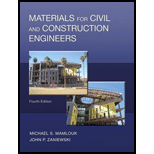
The specific gravity and absorption test (ASTM C128) was performed on fine aggregate and the following data were obtained:
Mass of SSD sand = 500.0 g
Mass of pycnometer with water only = 623.0 g
Mass of pycnometer with sand and water = 938.2 g
Mass of dry sand = 495.5 g
Calculate the specific gravity values (dry bulk, SSD, and apparent) and the absorption of the fine aggregate.
Want to see the full answer?
Check out a sample textbook solution
Chapter 5 Solutions
Pearson eText for Materials for Civil and Construction Engineers -- Instant Access (Pearson+)
Additional Engineering Textbook Solutions
Modern Database Management
Java: An Introduction to Problem Solving and Programming (8th Edition)
HEAT+MASS TRANSFER:FUND.+APPL.
SURVEY OF OPERATING SYSTEMS
Automotive Technology: Principles, Diagnosis, And Service (6th Edition) (halderman Automotive Series)
Mechanics of Materials (10th Edition)
- Three samples of fine aggregate have the properties shown in Table P5.9. TABLE P5.9 Sample Measure A B Wet Mass (g) 521.0 522.4 523.4 Dry Mass (g) 491.6 491.7 492.1 Absorption (%) 2.5 2.4 2.3 Determine in percentage: (a) total moisture content and (b) free moisture content for each sample and the average of the three samples.arrow_forwardThe specific gravity and absorption test (ASTM C128) were performed on fine aggregate. The following data were obtained.Given:Mass of SSD sand = 400.0 gMass of pycnometer with water = 520.0 gMass of pycnometer with water plus sand = 850.0 gMass of dry sand = 397.0 gRequired:a) bulk dry specific gravityb) bulk SSD specific gravityc) apparent specific gravity aaaaaaaaaaarrow_forwardThe following table provides data obtained during a specific gravity and absorption test on coarse aggregate. Using the data, determine the a) apparent bulk specific gravity, b) bulk SSD specific gravity, and c) absorption of the coarse aggregate.arrow_forward
- The specific gravity and absorption test (ASTM C128) were performed on fine aggregate. The following data were obtained.Given:Mass of SSD sand = 400.0 gMass of pycnometer with water = 520.0 gMass of pycnometer with water plus sand = 850.0 gMass of dry sand = 397.0 gRequired:a) absorption, in percentb) free moisture if the sand in the stockpile has a moisture content of 3% bbbbbbbbbbbbbbarrow_forwardA sieve analysis test was performed on a sample of coarse aggregate and produced the following results:A.) Calculate the fineness modulus of aggregate? Is in within the typical range?arrow_forwardThe specific gravity and absorption test (ASTM C128) were performed on fine aggregate. The following data were obtained.Given:Mass of SSD sand = 450.0 gMass of pycnometer with water = 550 gMass of pycnometer with water plus sand = 840 gMass of dry sand = 446.5 gRequired:a) bulk dry specific gravityb) bulk SSD specific gravityc) apparent specific gravityd) absorption, in percente) free moisture if the sand in the stockpile has a moisture content of 5%.arrow_forward
- A sieve analysis test for fine aggregates was performed on a sample of fine aggregates and produced the following results below. Determine the following: a. Percent passing through each sieve (Tabulation) b. Plot of the percent finer in the Semi-Log Gradation Chart c. Maximum Aggregate Size of the Sample (mm) d. Nominal Maximum Aggregate size of the sample e. Fineness Modulusarrow_forwardQuestion 2 Calculate the moisture content and absorption capacity for the following three aggregate samples. Report the moisture state of each aggregate. a) An aggregate sample from a stockpile A has a mass of 19.00 lb. When oven-dried, it has a mass of 17.98 lb. When brought to a saturated surface dry state it has a mass of 19.00 lb. b) An aggregate sample from a stockpile B has a mass of 5.08 kg. When oven-dried, it has a mass of 5.01 kg. When brought to a saturated surface dry state it has a mass of 5.13 kg. c) An aggregate sample from a stockpile C has a mass of 53.98 lb. When oven-dried, it has a mass of 53.22 lb. When brought to a saturated surface dry state it has a mass of 53.54 Ib.arrow_forwardTEST PROCEDURE: 1. Dry the aggregate test sample to a constant weight at a temperature of 110 ± 5°C, then cool to room temperature. 2. Select suitable sieve sizes to furnish the information required by the specifications covering the material to be tested. Common sieves in millimeters are 37.5, 25, 19, 12.5, 9.5, 4.75, 2.36, 1.18, 0.6, 0.3, 0.15, and 0.075 mm (11 2 in., 1 in., 3 4 in., 1 2 in., 3 8 in., No. 4, No. 8, No. 16, No. 30, No. 50, No. 100, and No. 200). 3. Nest the sieves in order of decreasing size of opening, and place the aggregate sample on the top sieve. 4. Agitate the sieves by hand or by mechanical apparatus for a sufficient period. The criterion for sieving time is that, after completion, not more than 1% of the residue on any individual sieve will pass that sieve during 1 minute of continuous hand sieving. 5. Determine the weight of each size increment. 6. The total weight of the material after sieving should be compared with the original weight of the sample placed…arrow_forward
- Please provide complete solution.arrow_forward1 - show complete solutionarrow_forward7 The specific gravity and absorption test (ASTM C128) was performed on fine aggregate and the following data were obtained:Mass of SSD sand = 500.0 gMass of pycnometer with water only = 623.0 gMass of pycnometer with sand and water = 938.2 gMass of dry sand = 495.5 gCalculate the specific gravity values (dry bulk, SSD, and apparent) and theabsorption of the fine aggregatearrow_forward

 Structural Analysis (10th Edition)Civil EngineeringISBN:9780134610672Author:Russell C. HibbelerPublisher:PEARSON
Structural Analysis (10th Edition)Civil EngineeringISBN:9780134610672Author:Russell C. HibbelerPublisher:PEARSON Principles of Foundation Engineering (MindTap Cou...Civil EngineeringISBN:9781337705028Author:Braja M. Das, Nagaratnam SivakuganPublisher:Cengage Learning
Principles of Foundation Engineering (MindTap Cou...Civil EngineeringISBN:9781337705028Author:Braja M. Das, Nagaratnam SivakuganPublisher:Cengage Learning Fundamentals of Structural AnalysisCivil EngineeringISBN:9780073398006Author:Kenneth M. Leet Emeritus, Chia-Ming Uang, Joel LanningPublisher:McGraw-Hill Education
Fundamentals of Structural AnalysisCivil EngineeringISBN:9780073398006Author:Kenneth M. Leet Emeritus, Chia-Ming Uang, Joel LanningPublisher:McGraw-Hill Education
 Traffic and Highway EngineeringCivil EngineeringISBN:9781305156241Author:Garber, Nicholas J.Publisher:Cengage Learning
Traffic and Highway EngineeringCivil EngineeringISBN:9781305156241Author:Garber, Nicholas J.Publisher:Cengage Learning





